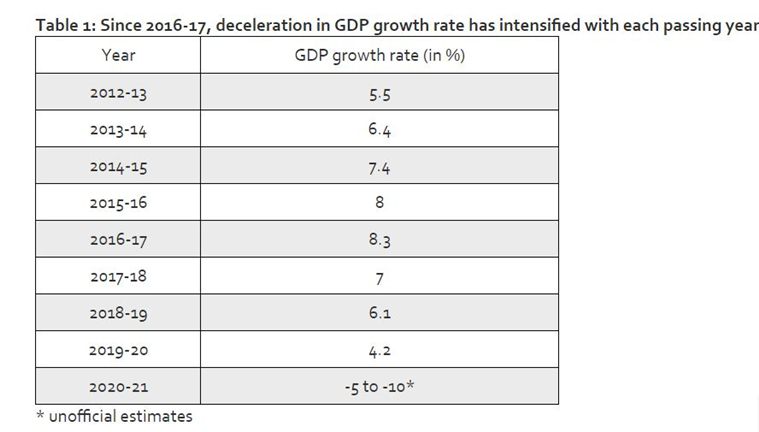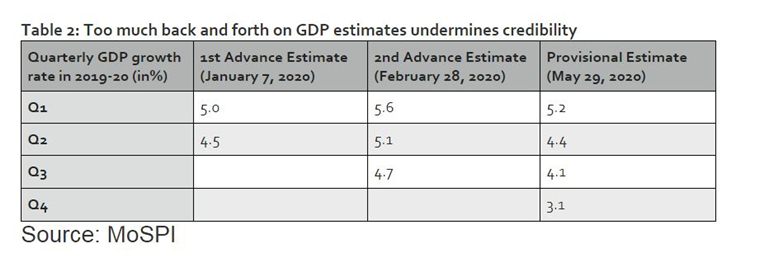Contents
- Anchoring ties with Canberra the virtual way
- What deceleration in GDP growth rate tells us?
- Throwing the Gauntlet: Beijing’s Posture
ANCHORING TIES WITH CANBERRA THE VIRTUAL WAY
Focus: GS-II International Relations
Why in news?
India-Australia virtual summit on 4 June, to focus on strengthening defence ties and WHO.
Introduction to India – Australia ties
- The New Delhi ranks extremely high on Australia’s diplomatic radar, almost all of Australia’s recent Prime Ministers have visited India.
- New Delhi’s relations with Canberra have acquired such spread and depth today that even without the undeniable belligerence of an increasingly inscrutable China, the summit would still have had salience and similar gravitas.
Relations with much potential
- Virtual summits are no longer a novelty, but India’s first bilateral summit is with Australia, and the convergence of interests and values has been patently obvious.
- The two countries have sought to reconstruct their increasingly turbulent regional geography into the Indo-Pacific.
- It is expected that the ‘Mutual Logistics Support Agreement’ will be signed during the summit that should enhance defence cooperation and ease the conduct of large-scale joint military exercises.
- In April 2019 Australia and India conducted AUSINDEX, their largest bilateral naval exercise, and there are further developments on the anvil, including Australia’s permanent inclusion in the Malabar exercise with Japan.
Pandemic control lessons
- Australia is one of the few countries that has managed to combat COVID-19 so far through “controlled adaptation” by which the coronavirus has been suppressed to very low levels. Two of the leaders of this great Australia-wide effort are Indian-born scientists.
- In terms of health and safe food as well the supply chains that facilitate their delivery, there are important lessons to be learnt.
Higher education
- The recovery of Australia’s universities, most of which are publicly funded and many among them rank among the top in the world, is still in question, but they are proving to be resilient and pioneers in distance and online learning.
- Australian universities could well open earlier than most and emerge as a safer destination for quality education than their European or Ivy league counterparts.
Analysis: India – Australia Relations, Issues in the past
- The historical ties between India and Australia initiated following the European settlement in Australia from 1788.
- Australia and India for the first time established diplomatic relations in the pre-Independence period, when the Consulate General of India was first opened as a Trade Office in Sydney in 1941.
- Following India’s independence, the Australian leaders advocated the British counterparts to retain the strategically important Andaman and the Nicobar Islands within the British Empire.
- During the Cold War, Australia had decided to be a close ally of the US, while India initially opted for Non-Alignment.
- Then there was the Pakistan factor. Australia’s attempts to act as the mediator between India and Pakistan in the 1940s and 1950s were not taken well by New Delhi.
- Over time, during the Cold War era, Australia opted for close ties with Pakistan – a close ally of the US – instead of India.
- Following the above – India-Australia relations touched a historic low when the Australian Government condemned India’s 1998 nuclear tests.
- Another issue that plagued the bilateral ties was the lack of people-to-people ties due to the “White Australia” policy that banned immigration from Asia and the Pacific Islands.
Improvements began when:
- In 2008, the Nuclear Suppliers Group had granted a waiver to India, leading to Australia lifting its uranium ban against the NPT non-signatories
- In 2014 Australia signed a uranium supply deal with India, the first of its kind with a country that is a non-signatory to the Nuclear Non-Proliferation Treaty, in recognition of India’s “impeccable” non-proliferation record it became evident what type of relation Australia wanted with India.
- The end of the Cold War and India’s decision to launch major economic reforms in 1991 ensured the development of closer ties between the two nations.
- India is among the largest contributors to Australia’s population growth. There is a massive influx of Indian students and tourists to Australia.
-Source: The Hindu
WHAT DECELERATION IN GDP GROWTH RATE TELLS US?
Focus: GS-III Indian Economy
Why in news?
- On 29th May 2020, Ministry of Statistics and Programme Implementation (MoSPI) released the data for the fourth quarter (January to March) of the last financial year (2019-20) as well as the provisional estimates of the full-year GDP growth rate.
- The provisional figure states that the Indian economy grew by 4.2% in 2019-20 which is the lowest annual growth rate of GDP registered under the new GDP data series which uses 2011-12 as the base year.
Nominal GDP plummets
- A similar fall to the one in GDP growth rate can be seen in the trajectory of the nominal GDP, which is the observed variable. Real GDP is arrived at by subtracting the nominal GDP growth by the inflation level.
- At the time of the 2019-20 Budget presentation in July, nominal GDP was expected to grow by 12%-12.5%.
- By the end of it, provisional estimates peg it at just 7.2%. In 2018-19, the nominal GDP grew by 11%.
- This sharp deceleration in nominal GDP growth, more than anything else, shows the continued weakening of India’s growth momentum even before it was hit by the Covid-19 induced lockdown in the last week of March.

Reflects poor fiscal marksmanship
- There are two reasons why this sharp deceleration in the nominal GDP matters.
- First of all, the nominal GDP growth rate is the base of all fiscal calculations in the country.
- A sharp divergence in nominal GDP growth rate basically upsets all other calculations in the economy.
- Secondly, the substantial deceleration in nominal GDP growth reflects poorly on the government’s fiscal marksmanship.
- In other words, it shows that the government was not able to assess the magnitude of economic growth deceleration that was underway.
Frequent and significant revisions in quarterly GDP
- India’s national income accounting data — the new GDP data series using 2011-12 as the base year — has come in for a fair bit of criticism in the past.
- While that debate is not yet settled, the credibility of India’s GDP estimates is not helped by frequent and significant revisions.
- The growth estimate for Q2 (July, August and September), for instance, has gone from 4.5% to 5.1% and back to 4.4% in a matter of just 5 months (between January and May 2020).

A warped economic structure
- Another key takeaway from the provisional GDP estimates is the undesirable emerging structure of the Indian economy.
- Together with services, manufacturing growth was supposed to absorb the millions still dependent on agriculture, which even when it grows fast, does not have the ability to raise per capita income in a big way.
- If India was to create lots of well-paying jobs that allow it to reap the so-called demographic dividend then it had to be via manufacturing growth.

Click Here to read more about the GDP Growth Rate data
-Source: Indian Express
THROWING THE GAUNTLET: BEIJING’S POSTURE
Focus: GS-II International Relations
Introduction to China’s Aggressive Pushes
- From the South China Sea to the streets of Hong Kong, and from Australian farmland to the Silicon Valley, everyone can feel the effects of Beijing’s increasingly aggressive posture.
- Even the tense exchanges between Chinese and Indian troops in the Himalayas must be understood not as a scuffle for a sliver of land, but as a diplomatic warning shot.
- India, Chinese leaders reckon, must understand the price it will pay for siding with the West in the contest for global leadership.
Troubled Waters
- New Delhi has tightened foreign investment rules that would bar opportunistic Chinese acquisition of Indian companies.
Click Here to read more about the FDI norms being changed (First Article)
- India’s latest move to join the US-led Quad and its attempt to disrupt Chinese domination of global supply chains must have raised further alarm.
- Although India downplayed the importance of the Quad Plus foreign ministers’ meeting as aimed mainly at dealing with Covid-19 issues, China could not have missed the significance of the grouping being expanded to include countries like New Zealand, South Korea and Vietnam.
Australia’s Moves
- The Quad Plus effort comes at a time when China, under increasing scrutiny for its policies, is in an aggressively retaliatory mode.
- Australia’s proposal to investigate the origins of the coronavirus has raised serious problems for the country with 35% share of its trade with China.
- Beijing responded by imposing 80% tariffs on Australian barley and banning imports of certain meat products.
- China’s threat to withdraw students from Australian universities and ban tourists from heading Down Under promises to punish Australia for siding with the US on strategic and technological issues like 5G.
Huawei in the mix
- Indications that the UK could rethink its earlier acceptance of Huawei as a limited partner in its 5G project have prompted stark threats of retaliation.
- Chinese threats that retaliation will “ripple far beyond technological concerns” comes a week after the US dealt a heavy blow to Huawei by banning a Silicon Valley chipmaker from supplying the company.
Click Here to read more about the 5G Club to counter Huawei (Fourth Article)
Hong Kong’s Status as a factor
- China’s plan to bring the territory under the jurisdiction of its own national security law and install its dreaded security agency in Hong Kong has already provoked an American response.
- By threatening to end democratic rights in Hong Kong, possibly triggering the withdrawal of Western businesses and their staff, China seems to be throwing down the gauntlet to the US and its partner.
Click Here to read more about the new Chinese Law on Hong Kong
Click Here to read more about China’s pressure in South China Sea
What India needs to watch out for?
Whether it is BRI, Huawei, Hong Kong, or its expansive claim to the South China Sea, Beijing has launched a wide-ranging challenge pitting Chinese nationalism against the world’s major democracies and international law.
What should concern India and other like-minded countries is this sobering reality: China appears economically and militarily prepared to absorb the shocks of Western retaliation; however, a divided West and its developing world allies, devastated by the coronavirus and economic uncertainty, may not be.
-Source: Times of India




